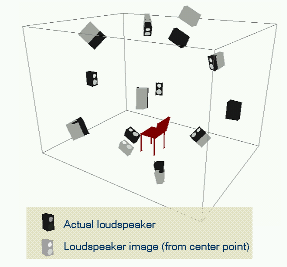| ambisonic rendering |
 |
| Project Home |
Listen Now |
About the Project |
Simulation Methods |
Ambisonic Rendering |
About the Binaural Web Demo |
Project Team |
 The
creation of these
highly accurate acoustical simulations are futile if a rendering system
is not available to present the sound simulations spatially. The
original presentation of these auralizations for review by critical
listeners dictated several requirements:
The
creation of these
highly accurate acoustical simulations are futile if a rendering system
is not available to present the sound simulations spatially. The
original presentation of these auralizations for review by critical
listeners dictated several requirements: